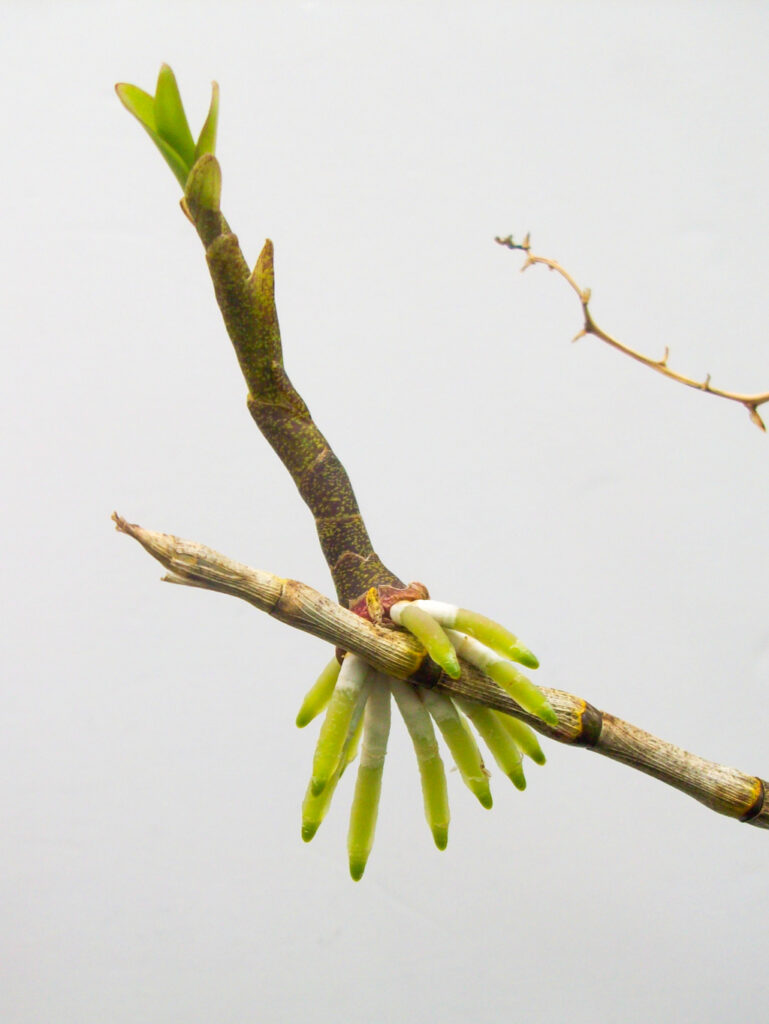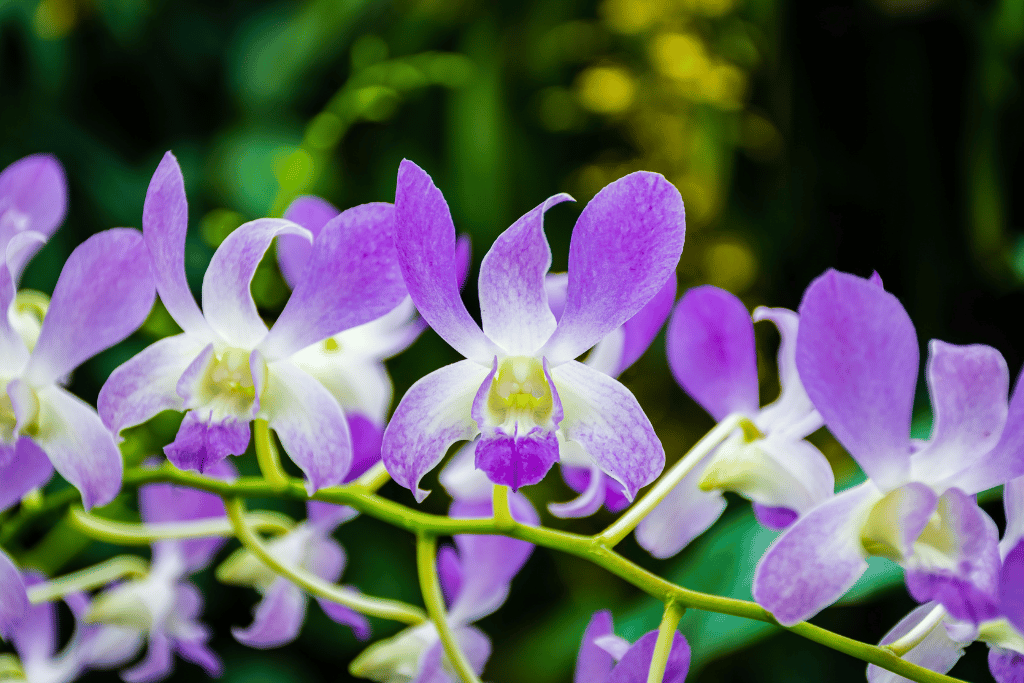Caring for orchids can be a pretty temperamental process, with many different factors influencing the health of your orchid. A mistake could cost the bloom for the year or the general health of the orchid for a period of time. Of course, we don’t want this, so it’s essential that we know how to care for orchids properly. By knowing this, we can make sure our orchids live a long and healthy life, but how long do orchids live?
70% of orchids are epiphytes, which means that they latch onto other organisms, such as a tree, sending out aerial roots to draw in moisture and nutrients for the plant. This is the opposite of terrestrial plants, which push their roots into the soil and take up moisture and nutrients. Orchids are typically found in tropical rainforests, but they can be found in other places, such as semi-arid regions and tundras.
Orchids are well adapted to their natural habitats; therefore, their care requirements match the environment they are native to. Therefore, this can make caring for orchids difficult if we can’t recreate these conditions in our homes. For example, in rainforests, the humidity usually sits around 70-80%. While we cannot reach this in our own homes, we can do things to increase the humidity, such as misting, drip trays or humidifiers.

Before we explore how long orchids live, let’s first go over how long they take to grow, as this can influence how long they live, from species to species.
How Long Do Orchids Take To Grow?
Most orchids we buy are typically mature, either from commercial supermarkets or nurseries which specialize in orchids. This saves us a lot of years having to wait for those beautiful blooms to appear, but it means we don’t have as much time with them!
We can use a few methods to propagate orchids, mainly cuttings, seeds and division. The majority of plants can be propagated by cuttings and seeds, but orchids are special due to the fact that they can be divided to form new plants.
Division
When we repot orchids, we have the opportunity to split the mother plant apart, letting us get the exact same orchid. By doing this, we can get mature orchids quickly and for free. Who doesn’t want a free orchid?
This will only work on species that are ‘sympodial‘. Sympodial means that the stems grow sideways next to each other, meaning they can be divided. This includes species such as Oncidium, Cattleya, Dendrobium and Cymbidium.
Of course, the main advantage of this method is that you can get a mature orchid for free while repotting your other one, helping it to thrive. Though, the main disadvantage to this method is that only a few species can be divided, so you’ll have to research which ones can before attempting this. Other methods of propagation, such as cuttings or by seed, may be suitable for species like Phalaenopsis (Moth) orchids which are common.
Cuttings
By far, this is my favorite method for propagating plants. Seeing new roots form from your cuttings is a fantastic feeling, as you’ve just created an entirely new plant by simply snipping a shoot off and sticking it in some soil. This is a bit more complicated for orchids, but it still follows the same process.
Some orchid species will produce keikis, essentially shoots from an orchid that will develop their own stem and roots. When these grow, we can remove them from the orchid and pot them into their own containers, which should eventually develop into a mature orchid in around two years.
Species that produce keikis include Epidendrum, Phalaenopsis and Dendrobium. Keiki are clones of the mother stock, so they’ll produce the same flowers as the orchid you took it from. They will only be produced when conditions are right, or alternatively, you can buy keiki paste which you can rub on the orchid in specific areas to stimulate the growth of a Keiki due to growth hormones.

Seeds
While it may be simple to grow other plants from seed, orchids can, unfortunately, be notoriously tricky. They have specific conditions which need to be met and certain mycorrhizal fungi to germinate. The timeframe can also be uncertain, with some orchids taking between 9 months to 2 years to finally germinate.
In nature, orchids produce millions of seeds to increase the chance of more germinating. Fun fact – a gram of Cycnoches chlorochilon (a tropical American orchid) contains almost four million seeds!
The main advantage to raising orchids from seed is that you might be able to create new hybrids of orchids, which could have different characteristics or different coloured flowers! In terms of variation, this is a lot better than cuttings or division, as they only produce genetically identical plants. The main disadvantage of growing from seed is the time frame. Growing orchids from seed are typically only done by advanced growers or nurseries with a lot of experience.
How Long Do Potted Orchids Live?
Potted orchids are much less hardy than in their natural habitats. Their own environments essentially have the perfect conditions for them, while we likely only have optimal conditions. Makes you feel bad, doesn’t it?
In the wild, orchids can typically live for around 20 years. Potted orchids usually live for about 10-15 years; however, some may only last for a short time or will even last longer, depending on the quality of care given to the orchid.
There are factors which will influence how long your orchids live, such as the species, watering, fertilizing, light and temperature you give it. Different species will have different conditions they like, so it’s best to do your research into species.
Phalaenopsis
Among one of the most common species of orchids bought, Phalaenopsis, or Moth orchids as some people refer to them, can live for about 10-15 years. They are one of the easiest to care for species of orchids and are available in every orchid nursery or supermarket for a low price.
The first orchid I ever got was a moth orchid, and it’s still living and throwing out blooms years later! Many people tend to throw their orchid out after it blooms, but what’s the point of that? You can get new blooms relatively easily; some species might even flower a second time for you if they’re getting good care.
Phalaenopsis orchids should be placed in a position where they receive indirect or filtered light, with a stable temperature from around 12-23 degrees. They should be watered about once a week; however, I’m not particularly eager to stick to a strict schedule. Instead, I poke my finger an inch deep into the soil. If it’s still soggy, I’ll hold off on watering until it dries out slightly. This is a fool-proof method that helps prevent overwatering or underwatering.
Ideally, your orchids should be kept in high-humidity conditions. I like to use drip trays full of grit which I water every so often to increase the humidity around the orchids, but you can use other alternatives, such as misting. If you mist your orchids, though, make sure that you do it early in the day to ensure the water has time to evaporate so that it doesn’t rot the leaf overnight.
Dendrobium
Dendrobiums are quite versatile orchids, and in terms of light intensity, they’re a lot hardier than other orchids. Like moth orchids, they can also live for about 10-15 years.
These types of orchids should be kept in pretty warm temperatures, from about 20 to 29 degrees. At night, they should be experiencing a drop in temperature of about 10 degrees. Dendrobiums can also be watered about once a week, but ensure you check the soil’s moisture frequently.
You’ll find that with orchids (or any plant), their water demand will likely be much higher in summer than winter, as they are increasing growth in summer. More water means more energy can be produced for the plant, which is needed for more vegetative growth or to keep flowers going to set seed.

Dendrobiums’ bloom is usually between February to June, putting on vegetative growth until around September. After this, the orchid will enter a dormant phase, eventually coming out of it again and repeating this cycle.
Final Thoughts
In this article, we’ve gone over some of the reasons related to how long orchids live and different common species. Overall, I would say that as long as you are ensuring your orchids are getting a good quality of care, they’re much more likely to survive for longer.
Frequently Asked Questions (FAQ)
How long do orchid blooms last for?
This will depend on the species and the care you give it. Some species, like Phalaenopsis, can last 6-8 weeks when blooming, while others, like Cattleya’s blooms, will only last for about two weeks. Making sure that your orchids are in a reasonable amount of light, getting a good amount of water and a bit of fertilizer will ensure that your orchid stays blooming for a long time and in the future too.
Is my orchid dead after its flowers fall off?
Nope! Many people are under the misconception that once the orchid that they got as a gift has finished blooming, it’s essentially done for. This isn’t true at all, and you just need to ensure that you give it the proper care to recover after blooming. Within about a year, you’ll likely get another set of blooms and maybe even more than last time! When orchids are dying and how to revive an orchid, they usually put out other signs such as yellowing or browning of stems and leaves or a change in the appearance of roots.
When will my moth orchid’s flowers fall off?
With Phalaenopsis orchids, their flowers will usually fall off somewhere between late June and July. They typically start blooming in late winter through to the spring. When your orchid has stopped blooming, you can resume care for it like normal, and if it needs a repot, this would be the ideal time.
What should I do with flower spikes after the flowers fall off my orchid?
Once your blooms have gone, you have three choices with the flower spike. You can leave it fully intact, cut it back to a node, or completely remove it. I like to keep them on my orchid, but if you find that this is causing problems for your orchid, then the best option would be to remove it. With moth orchids, you’ll find that they have the chance to rebloom again from the same flower spike, so this is why I like to keep mine on the orchid.



